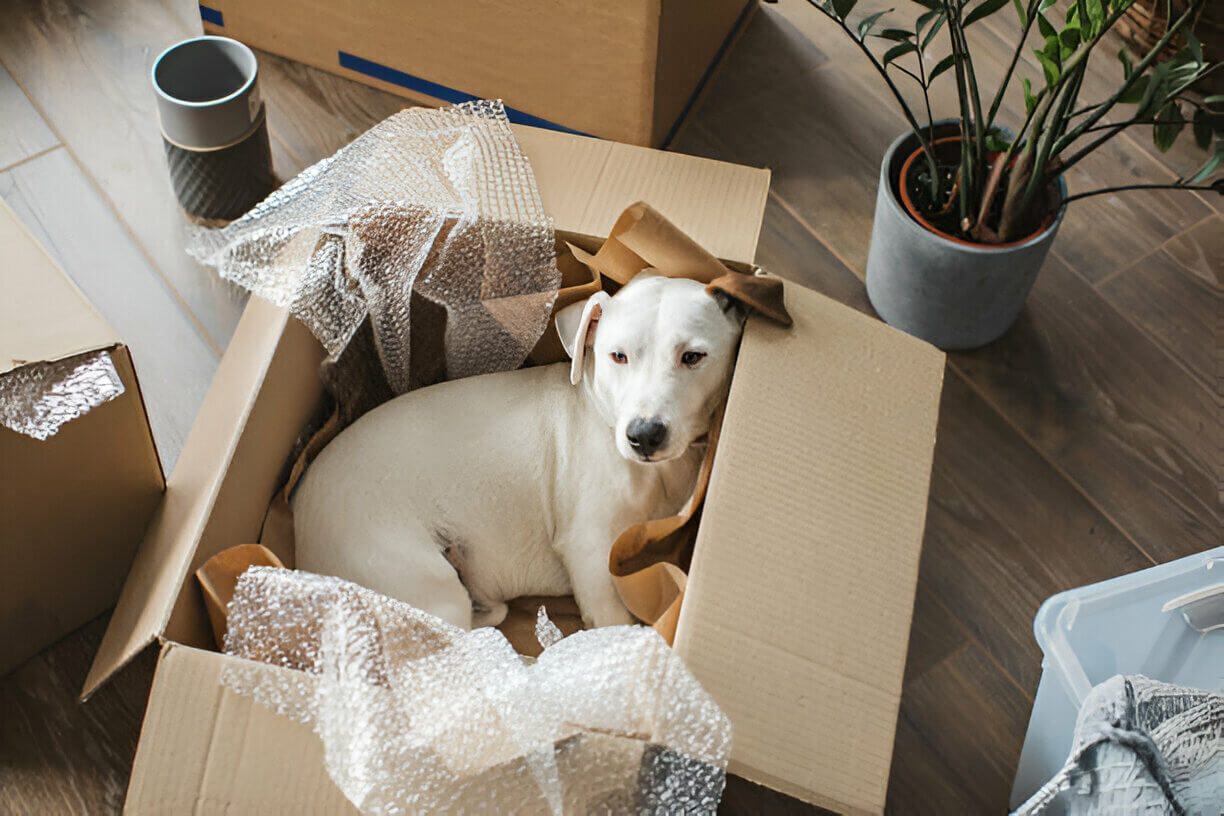Moving can be a stressful experience for everyone involved, especially for our furry friends. Dogs thrive on routine and familiarity, so a change in environment can cause anxiety and confusion. This guide provides essential tips to ensure a smooth transition for your dog when moving to a new house.

Preparing for the Move
Plan Ahead
Check Local Regulations: Before moving, research the local laws regarding pet ownership in your new area. This includes leash laws, breed restrictions, and licensing requirements. Knowing these regulations in advance helps prevent any surprises after you move, ensuring you can quickly adapt to the new community’s requirements.
Find a New Vet: Identify a new veterinarian close to your new home. Having a vet nearby is crucial in case of emergencies. Make sure your dog is up-to-date with vaccinations and has all necessary medications. Schedule an initial appointment soon after your move to establish care and familiarize yourself with the clinic.
Microchip and ID Tags: Ensure your dog’s microchip information is updated with your new address. Additionally, update their ID tags to include your new contact details. This is essential in case your dog gets lost during the move. The updated information will help in quickly reuniting you with your pet.
Familiarize Your Dog with Moving Supplies
Dogs can become anxious at the sight of moving boxes and suitcases. Gradually introduce these items to your dog by having them out in the open well before the move. Let your dog sniff and explore these items to reduce their association with stress. This helps your dog acclimate to the changes happening in their environment.
Visit the New Home
If possible, take your dog to the new home before the actual move. Let them explore the house and yard. Familiarity with the new environment can reduce anxiety on moving day. If a visit isn’t possible, try walking your dog in the new neighborhood to get them used to the new surroundings. This pre-move visit can make the actual moving day less intimidating for your dog.
Packing and Moving Day
Keep Routine Consistent
Dogs are creatures of habit. Try to maintain their regular feeding, walking, and play schedules throughout the moving process. Consistency in routine provides a sense of security amidst the chaos of moving. Stick to your dog’s daily schedule as much as possible to minimize stress and anxiety.
Create a Safe Space
Set up a designated safe area for your dog in both your current and new homes. This space should include their bed, toys, and blankets. Keeping some familiar scents and items around will help them feel more secure.
During the Move: On moving day, consider placing your dog in a quiet room away from the hustle and bustle. Alternatively, having them stay with a friend, family member, or at a boarding facility can keep them away from the stress of moving. This ensures your dog is safe and relaxed while you handle the logistics of the move.
Traveling
Ensure your dog is comfortable during the journey. Use a well-ventilated crate or car harness to keep them secure. Make regular stops for bathroom breaks and to allow your dog to stretch their legs. If your dog experiences motion sickness or anxiety, consult your vet about possible medications or treatments. A comfortable and safe travel setup is crucial for a stress-free journey.
Arriving at the New Home
Set Up Your Dog’s Space First
Before bringing your dog into the new house, set up their space with familiar items like their bed, toys, and water bowl. Having their belongings in place can provide comfort and help them adjust more quickly. Creating a familiar and cozy environment helps your dog feel more at home.
Gradual Introduction
Let your dog explore the new home at their own pace. Supervise them initially to ensure they don’t get into anything harmful. Use a cheerful tone and offer treats to create a positive association with the new environment. Allowing your dog to explore and sniff around helps them get used to the new scents and layout of the house.
Post-Move Adjustments
Maintain Routine
Continue to keep your dog’s routine as consistent as possible. Feed them at the same times and in the same locations as in the old house. Regular walks and playtime are crucial for helping them settle in. Sticking to a familiar routine provides stability and reduces anxiety.
Provide Extra Attention
During the initial days and weeks, give your dog extra attention and reassurance. Spend quality time with them to help them feel secure. Play sessions and mental stimulation can also help reduce anxiety. Engaging with your dog in familiar activities helps reinforce their sense of security and normalcy.
Long-Term Considerations
Monitor Behavior
Watch for any signs of stress or anxiety, such as changes in appetite, excessive barking, or destructive behavior. If these issues persist, consult your veterinarian for advice and possible treatments. Early intervention can prevent long-term behavioral issues.
Socialization
If your new home has other pets or children, introduce them to your dog gradually. Supervised interactions and positive reinforcement can help your dog adjust to new family members. Take the time to properly introduce your dog to the new environment and any new residents.
Conclusion
Moving house with a dog requires careful planning and attention to detail. By preparing in advance, maintaining routines, and providing comfort and reassurance, you can help your dog transition smoothly to their new home. Remember, patience and consistency are key to making the move as stress-free as possible for your furry friend.




